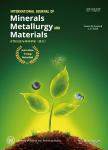版权所有:内蒙古大学图书馆 技术提供:维普资讯• 智图
内蒙古自治区呼和浩特市赛罕区大学西街235号 邮编: 010021

作者机构:State Key Laboratory for Advanced Metals and Matefiai University of Science and Technology Beijing Beijing 100083 China R&D Center Baosteel Advanced Technology Institute Shanghai 201900 China School of Material Science and Engineering University of Science and Technology Liaoning Anshan 114044 China
出 版 物:《Journal of University of Science and Technology Beijing》 (北京科技大学学报(英文版))
年 卷 期:2007年第14卷第5期
页 面:420-424页
核心收录:
学科分类:08[工学] 080502[工学-材料学] 0805[工学-材料科学与工程(可授工学、理学学位)]
基 金:This work was financially supported by the National Natural Science Foundation of China (No.50572005) the National Science Fund for Distinguished Young Scholars (No.50325209), and "863" Program (No.2006AA03Z351)
主 题:austenite stainless steel casting thin strip morphology microstructure
摘 要:The microstructure of AISI 304 austenlte stainless steel fabricated by the thin strip casting process were investigated using optical microscope, scanning electron microscope (SEM), transmission electron microscope (TEM), and X-ray diffraction (XRD). The microstructures of the casting strips show a duplex structure consisting of delta ferrite and austenite. The volume fraction of the delta ferrite is about 9.74vo1% at the center and 6.77vo1% at the surface of the casting thin strip, in vermicular and hand shapes. On account of rapid cooling and solidification in the continuous casting process, many kinds of inclusions and precipitates have been found. Most of the inclusions and precipitates are spherical complex compounds consisting of oxides, such as, SiO2, MnO, Al2O3, Cr2O3, and FeO or their multiplicity oxides of ***2O3, ***2, and ***2. Many defects including dislocations and stacking faults have also formed during the rapid cooling and solidification process, which is helpful to improve the mechanical properties of the casting strips.